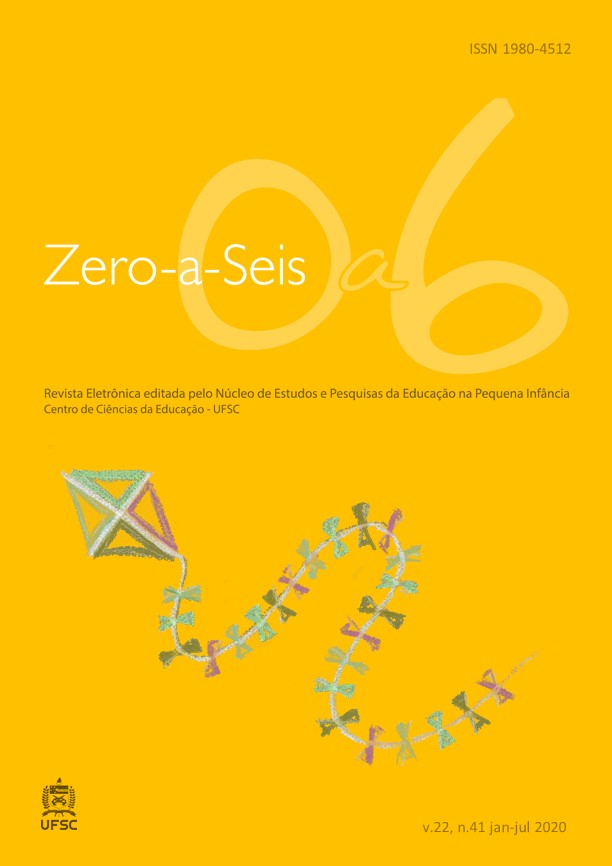Educação física na educação infantil: entre a suspeita e o diagnóstico de autismo
DOI:
https://doi.org/10.5007/1980-4512.2020v22n41p274Abstract
O presente texto lança luz sobre as práticas avaliativas e pedagógicas que se tem desenvolvido no CMEI Constelação e de que forma a Educação Física tem ajudado as crianças com autismo, e com hipótese de TEA. O objetivo é apresentar essa tensão entre a suspeita e o diagnóstico de autismo, os diálogos com as famílias e os encaminhamentos que ocorreram em 2017 e de que forma a Educação Física tem contribuído com a superação das limitações impostas pelo autismo, mas também, valorizando as potencialidades de cada sujeito. As famílias que aceitaram as indicações de investigar o comportamento de seus filhos/filhas, e acolheram as suspeitas levantadas pelos professores e profissionais envolvidos com a educação das crianças, relataram uma melhora significativa na superação de barreiras impostas pelo transtorno. As intervenções pedagógicas, mesmo na ausência de um diagnóstico precoce, colaboraram para ampliar as capacidades das crianças e reduzir os impactos do TEA nas dimensões comunicativas, sociais e comportamentais.
Literaturhinweise
ANDRADE, Aline Abreu; COSTA, Ana Paula F. A importância do brincar para o desenvolvimento. (in:) CAMARGOS JUNIOR, Walter (Org.). Intervenção precoce no autismo: guia multidisciplinar de 0 a 4 anos. Belo Horizonte: Artesã, 2017.
AYOUB, Eliana. Reflexões sobre a Educação Física na Educação Infantil. Revista Paulista De Educação Física, (supl.4), 53-60, 2001.
BRASIL. Ministério da Educação. Diretrizes curriculares nacionais para a Educação Infantil. Brasília, DF: 2010.
CAMARGOS JUNIOR, Walter (Org.). Intervenção precoce no autismo: guia multidisciplinar de 0 a 4 anos. Belo Horizonte: Artesã, 2017.
GONRING, Adriana; DOTZAUER, Daniela (Orgs). Quem é meu filho? Autismo, Psicanálise e Arte. Vitória: PIPA, 2017.
GADIA, Carlos; BORDINI, Dionízioa; PORTOLESE, Joana. Estratégias de identificação: autismo – como identificar. (In:) Autismo e Realidade. Cartilha autismo e a educação. São Paulo: 2013. Disponível em: http://autismo.institutopensi.org.br/wp-content/uploads/manuais/Cartilha-AR-Out-2013.pdf. Acesso em: 09/12/2017.
GRANDIN, Temple; PENEK, Richard. O cérebro autista: pensando através do espectro. Rio de Janeiro: Record, 2015.
MARTINS, Lígia Martins. O desenvolvimento do psiquismo e a educação escolar: contribuições à luz da psicologia histórico-cultural e da pedagogia histórico-crítica. Campinas, SP: Autores Associados, 2013.
ORRÚ, Sílvia Ester. Aprendizes com autismo: aprendizagem por eixos de interesse em espaços não excludentes. Petrópolis, RJ: 2016.
THOMPSON, Travis. Conversa franca sobre autismo: guia para pais e cuidadores. Campinas, SP: Papirus, 2014.
VYGOTSKY, Lev S. Pensamento e linguagem. Trad. Jefferson Luiz Camargo. São Paulo: Martins, 2005.
Downloads
Veröffentlicht
Ausgabe
Rubrik
Lizenz
Copyright (c) 2020 Alexandre Freitas Marchiori

Dieses Werk steht unter der Lizenz Creative Commons Namensnennung - Nicht-kommerziell 4.0 International.
As pessoas autoras cedem à revista Zero-a-Seis os direitos exclusivos de primeira publicação, com o trabalho simultaneamente licenciado sob a Licença Creative Commons Attribution (CC BY) 4.0 International. Esta licença permite que terceiros remixem, adaptem e criem a partir do trabalho publicado, atribuindo o devido crédito de autoria e publicação inicial neste periódico.
As pessoas autoras têm autorização para assumir contratos adicionais separadamente, para distribuição não exclusiva da versão do trabalho publicada neste periódico (ex.: publicar em repositório institucional, em site pessoal, publicar uma tradução, ou como capítulo de livro), com reconhecimento de autoria e publicação inicial neste periódico.



